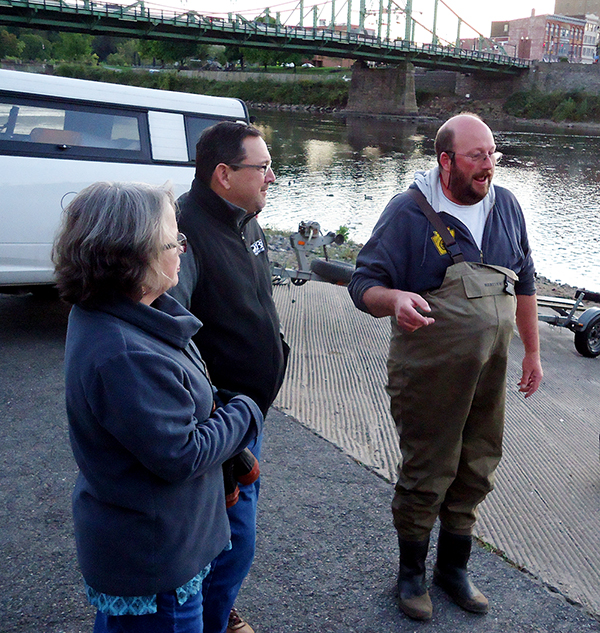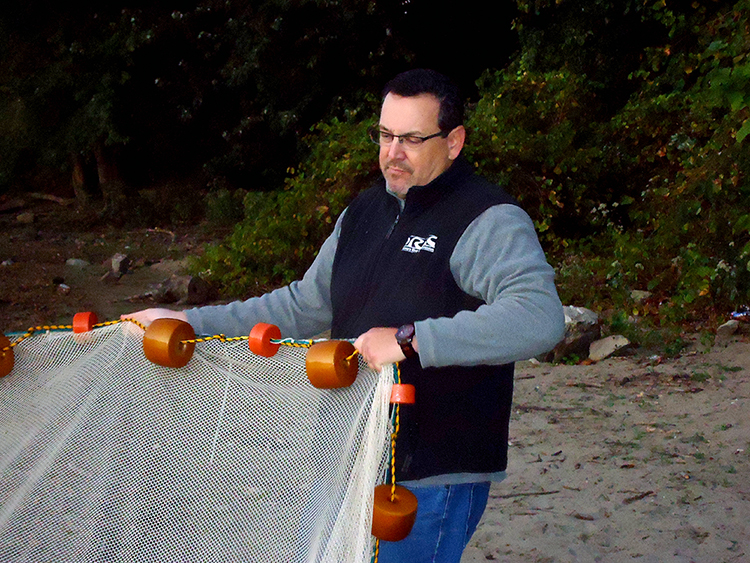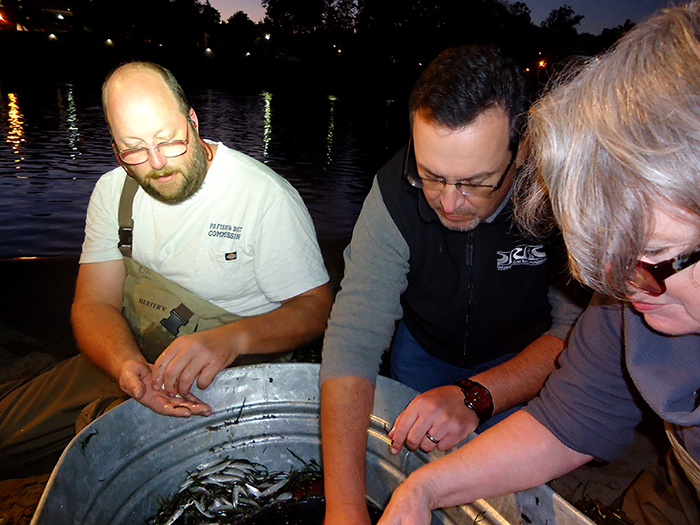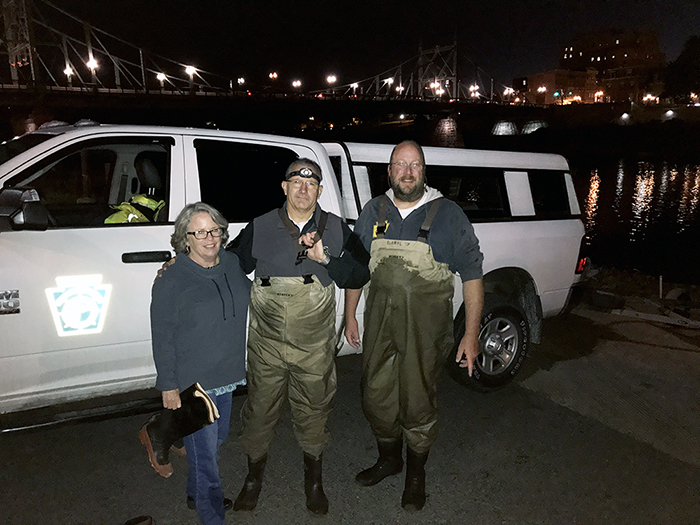Delaware • New Jersey • Pennsylvania
New York • United States of America
In addition to being active throughout the year sampling the Delaware River and analyzing data for its various water quality programs, DRBC staff periodically assist with monitoring efforts led by partner agencies or basin cooperatives.
Commission staff once again helped basin state and federal fisheries biologists during the late summer and fall by providing manpower and expertise to count numbers of juvenile American shad in the non-tidal Delaware River. American shad, a member of the herring family, are anadromous fish, meaning they are born in fresh water, live for several years as adults in the ocean, and return to their natal waters (where they're born) to spawn (lay their eggs) in the spring. Juvenile American shad, called young-of-the-year (YOY), are those that are born in the spring and spend their first summer in the river. As the water temperatures cool, they travel south to overwinter in the warmer waters of the Delaware Estuary and Bay before heading out to the Atlantic Ocean.
To help determine how well the fishery is doing each year, YOY shad numbers are monitored in the non-tidal Delaware as they travel downriver towards the estuary. The shad are collected by seining, using a large net to catch the fish in the river. Other fish species are also caught, and the fisheries team must then sort and identify which are YOY shad so their numbers can be recorded.
In August, September, and October 2017, six different sites - Trenton, N.J., Phillipsburg, N.J., Delaware Water Gap, Pa., Milford Beach, Pa., Skinner’s Falls (Milanville, Pa.), and Fireman's Launch (East Branch Delaware River) - were monitored once monthly, for a total of 18 data points. The data collected from these surveys support an approved management plan that is in place to ensure that the fishery remains viable and sustainable.
The YOY surveys are organized by the Delaware River Basin Fish and Wildlife Management Cooperative (Co-Op), made up of fisheries representatives from the Delaware Division of Fish and Wildlife, N.J. Division of Fish and Wildlife, New York State Division of Marine Resources, Pennsylvania Fish and Boat Commission, U.S. Fish and Wildlife Service, and the National Marine Fisheries Service. DRBC is a liaison member to the Co-Op. Other supporting agencies include the National Park Service, the Philadelphia Water Department, and the Nature Conservancy.
In 2017, DRBC staff participated in this voluntary and cooperative survey effort five times at three different locations: in August at Phillipsburg, N.J., in September at Trenton, N.J. and Phillipsburg, N.J., and in October at Phillipsburg, N.J. and Milford, Pa. Staff helped seine, sort, and count the numbers of YOY shad collected.
In advance of the October sampling event at Phillipsburg, DRBC reached out to the offices of several local legislators and officials to invite them to participate. We were pleased to have N.J. State Senator Michael Doherty (Legislative District 23)’s Chief of Staff Patti Boynton and the Mayor of Phillipsburg Stephen R. Ellis join DRBC staff and the other volunteers at the Phillipsburg boat ramp. Inviting government officials to participate in these types of events helps further develop our working relationships, as well as educate them on DRBC and the river.
DRBC staff work hard to fulfill the commission’s mission of managing and protecting the basin’s water resources. Being able to partner with other agencies on their monitoring efforts and use these opportunities to teach others about DRBC and what we do, are also important parts of that mission.
According to Daryl Pierce of the Pennsylvania Fish and Boat Commission, provisional data from this year’s annual catch makes 2017 the time-series (1988-2017) high, surpassing other years of high non-tidal YOY catch numbers. The three locations used by the Co-Op to determine overall annual catch numbers are Phillipsburg, N.J., Delaware Water Gap, Pa., and Milford Beach, Pa.
Additionally, the Co-Op has some indication that the non-tidal YOY numbers are correlated to the numbers of adult American shad that subsequentially return in later years to the Delaware River each spring to spawn.
American shad typically live in the ocean for about five years before returning to the river to lay their eggs. The Lewis Fishery is the last commercial shad fishery in New Jersey; they fish for shad each spring using the traditional seining method, the same method used to collect the non-tidal YOY shad. Data collected is shared with the Co-Op. For the Lewis Fishery, 2017 was the best year of returning American shad they had recorded since 1995.
Seeing higher numbers of non-tidal YOY shad and seeing higher numbers of returning adult shad are hopefully both good trends for Delaware River American shad.
Historically, American shad have spawned in the mainstem Delaware River, as well as in several of its tributaries. Today, the Delaware River continues to support American shad, thanks in part to the absence of dams on the mainstem river and to water quality that has seen significant improvement over the years due to efforts of DRBC and other stakeholders.
The Atlantic States Marine Fisheries Commission (ASMFC), formed by the Atlantic Coast states to manage, promote, and protect their shared migratory fishery resources, has required all states to submit sustainability plans for American shad or face potential closure of their recreational and commercial fisheries.
In the Delaware River Basin, the Co-Op is responsible for the management of American shad (and other fish species). It developed a sustainable fishing management plan for American shad (pdf 5 MB), which was accepted by ASMFC. The plan includes several indices for monitoring the shad numbers in the Delaware Basin with associated benchmarks. One of the indices measured is the non-tidal juvenile abundance index (JAI) of YOY American shad, which is supported by data from the seining surveys. The benchmarks have been set to respond to any potential decline in stock.
Monitoring how many YOY shad are caught returning to the ocean provides a relative index of abundance for comparing to the benchmark, which then allows fisheries biologists to estimate the relative status of YOY production. Should the YOY shad non-tidal JAI fall below the pre-determined benchmark, management would be enacted to strengthen protection of the American shad population.
Another benchmark included in the management plan is the tidal JAI, which N.J. Fish and Wildlife collects data for independently at locations in the river's tidewaters. This monitoring effort gives additional information on shad spawning success and further supports the management plan. As with the non-tidal JAI, management action would be enacted if the tidal JAI falls below the pre-determined benchmark.
The Delaware River is an important waterway for American shad, and its fishery is currently considered sustainable, albeit at low levels. Non-tidal JAI surveys and others provide important data on the status of the Delaware River's American shad population. The fact that there is an approved management plan with relative indices for monitoring trends and associated benchmarks will permit growth of the DRB American shad stock while allowing for human use of the resource.
The DRBC is a strong supporter of these efforts and is committed to providing staff expertise and manpower to future monitoring efforts when needed.
Copyright © Delaware River Basin Commission,
P.O. Box 7360, West Trenton, NJ 08628-0360
Phone (609)883-9500; Fax (609)883-9522
Thanks to NJ for hosting the DRBC website











